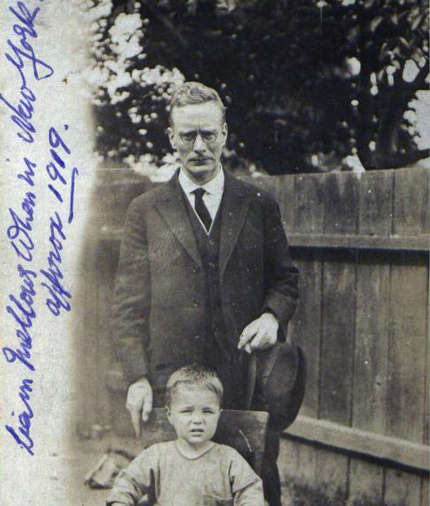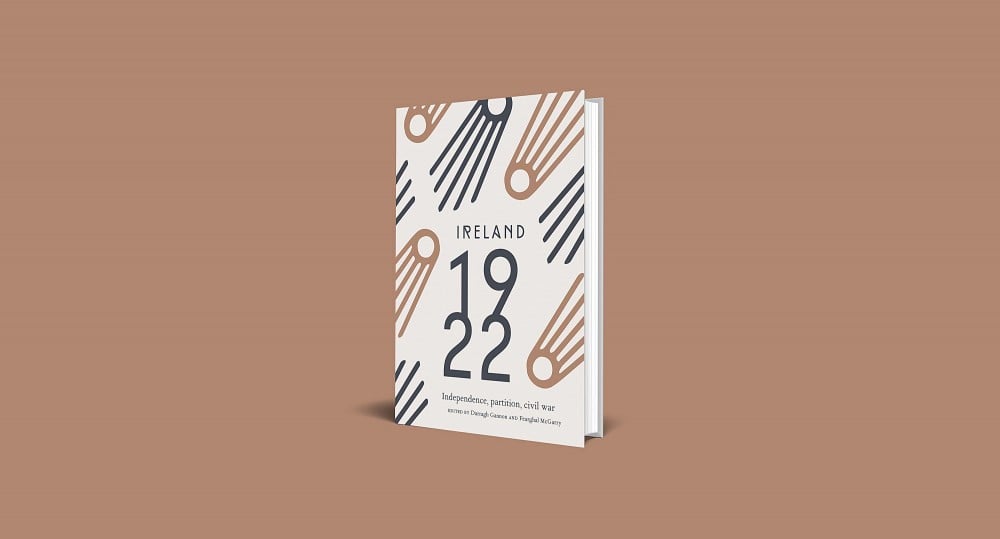22 September 1922: The Publication of Liam Mellows’s ‘Notes From Mountjoy’
Class, Social Revolution, and Republicanism In The Civil War
by Gavin Foster
On 22 September 1922, roughly three months into the Irish civil war, both the Irish Independent and the Freeman’s Journal reprinted IRA correspondence recently smuggled out of Mountjoy jail.¹ They did so at the behest of the Provisional Government, which instructed its publicity department to circulate the intercepted material to the pro-Treaty press, accompanied by an official statement.² Only one of many targets in the nascent regime’s propaganda campaign against the anti-Treaty cause, the so-called ‘Notes from Mountjoy’ or ‘Jail Notes’, acquired a historical and historiographical influence far beyond their limited impact during the 1922–3 conflict.
Their author was Liam Mellows (1892–1922), in Provisional Government custody since 30 June when the republican garrison in Dublin’s Four Courts fell following two days of heavy fighting that started the civil war. Mellows had been an exceptionally energetic republican activist during the preceding decade, with a reputation as one of the more forward-thinking and (relatively) socially conscious IRA leaders. Pre-1916 he had been a key organiser for Na Fianna Éireann, the IRB and the Irish Volunteers, while during Easter Week he helped lead the mini-rising in Galway. After several years promoting Sinn Féin in the US, he returned home in 1920, taking a place on the IRA’s HQ staff and representing County Galway in the Dáil. Mellows achieved national prominence for his principled arguments against the Treaty during Dáil debates and in public speeches that preceded the civil war.³ Amidst the anti-Treaty camp’s failing military and political fortunes throughout July and August, Ernie O’Malley—who was among a number of high-profile republicans growing dissatisfied with IRA Chief of Staff Liam Lynch’s rigidly martial outlook—solicited Mellows’s advice on policy ideas that might rescue the republican cause from irrelevance and defeat. Contacted in Mountjoy on 18 August, Mellows wrote up his suggestions in a series of notes, producing part one on 26 August and part two on 29 August, with a short postscript on 11 September. With two slightly different versions and several copies smuggled out, a set of the notes fell into the hands of Provisional Government authorities, leading to their subsequent release to the press.⁴
Mellows’s ‘Jail Notes’ were shaped by discussions he held with fellow anti-Treaty prisoners, including northerner Joseph McKelvey, Corkman Richard Barrett, Donegal republican-socialist Peadar O’Donnell and several other republicans in the trade-union movement. The radical tenor of their musings was influenced by the Workers’ Republic, the then Communist Party of Ireland newspaper run by Roderick Connolly, carrying on his late father’s legacy.⁵ The miniscule communist party had been virtually alone in southern Ireland in cheering on the country’s slide towards civil war, based on the ideological logic that the conflict could break ‘bourgeois’ control over the independence movement and lead to a socially revolutionary situation in Ireland. It relentlessly advocated a radical policy turn for republicans, entailing a worker-run state with full control over banks, natural resources, public utilities and all private property, especially large land holdings.⁶ In his messages back to O’Malley (and Austin Stack), Mellows approvingly quoted a summary of the Communist Party of Ireland programme from the 22 July issue of Workers’ Republic (the same issue to which he contributed a piece chastising pro-Treaty labour for compromising with imperialism and capitalism and betraying James Connolly.)⁷
Much of Mellows’s schematic ‘Jail Notes’ concerned propaganda. Its suggested themes included imperialism (the ‘Irish Free State as a Colony’); the reality of the ‘Republic’ as manifested in Dáil Éireann’s administrative activities and President de Valera’s political ‘miracles’ abroad; the pro-Treaty Roman Catholic Church hierarchy’s ‘abandonment of principle’; and South Africa’s object lessons for Ireland. He also devoted passing attention to India, communications, courts, by-elections and the Fianna. His most substantive ideas, however, dealt with republican political organisation and social policy; unusual priorities for a ‘die-hard’ on the military side of the movement. He stressed the urgent need for a ‘Provisional Republican Government’ (‘even if it is unable to function’) to provide a ‘rallying centre’ for supporters and to challenge the legitimacy of treatyite institutions. On social policy, he argued that since official labour had ‘deserted the people for the flesh-pots of Empire’, republicans must assume the vanguard with a radical industrial-economic programme tied to land redistribution. Although he endorsed ‘something like’ the Workers’ Republic formulation mentioned above, he insisted that such a policy was not a departure for republicans, only a belated effort to translate the Dáil’s 1919 Democratic Programme ‘into something definite’. In his most memorable lines, Mellows dramatically articulated the historical stakes and class implications of the civil war for the anti-Treaty cause: ‘We are back to [Theobald Wolfe] Tone—and it is just as well—relying on that great body, “the men of no property”. The “stake in the country” people were never with the Republic’.⁸
In its statement introducing the ‘Jail Notes’ in the press, the Provisional Government predictably pounced on the ‘avowedly’ communistic inspiration behind Mellows’s ideas. Its main critique, however, was that his was an opportunistic and disingenuous ‘fall back…plan’ for beleaguered republicans, a desperate gambit to ‘bribe’ (and fool) the landless and unemployed with ‘plunder’ ‘from another section of the people’. Accused by Mellows of becoming ‘Imperialist and respectable’, the official labour movement was, unsurprisingly, ill-disposed to his notion that unemployment, starvation, and recent strikes might be advantageously ‘utilized for the Republic’. It persevered in its balancing act of pushing for labour reforms inside the treatyite parliament, while freely criticising both sides in the split. Only the Communist Party of Ireland (CPI) and a few left-leaning republican commentators publicly hailed Mellows’s policy ideas at the time.⁹ Crucially, his appeal failed to gain traction inside the anti-Treaty movement, apart from the setting up of a notional Republican Government that had little impact or influence before the IRA abandoned its moribund campaign in May 1923.
When Lynch escalated the IRA’s campaign by ordering assassinations to counter government executions, Mellows, along with McKelvey, Barrett and imprisoned Four Courts commander Rory O’Connor, became collateral victims. Immediately following an IRA attack that killed pro-Treaty TD Seán Hales (while wounding Pádraic Ó Máille), ‘Rory, Liam, Dick and Joe’ were selected for reprisal execution by the executive council of the newly christened Irish Free State and shot by firing squad on the morning of 8 December. Despite the mutual hostility between the Labour party and anti-treatyites, labour deputies Thomas Johnson and Cathal O’Shannon delivered blistering condemnations of the government’s legally questionable action.¹⁰
In his religiously infused final letters, Mellows welcomed the ‘greatest human honour’ of joining Tone, Emmett, Pearse and Connolly in republican martyrdom.¹¹ He subsequently achieved legendary status within the anti-Treaty republican tradition, especially among iterations of left republicanism, from Republican Congress and Saor Éire in the 1930s, to the CPI and Official IRA in the 1960s and ’70s, to republican-socialist factions that hold commemorations at his grave in Wexford to this day. Peadar O’Donnell extolled his friend as ‘the richest mind our race had achieved for many a long day’, while Mellows’s biographer, British socialist activist and historian C.D. Greaves, concluded that with his republican fighting credentials, staunch anti-imperialism and dawning class-consciousness, Mellows was the worthiest successor to Connolly in the revolution.¹²
Later Marxist and revisionist historians have challenged Mellows hagiography by sharply questioning his alleged conversion from Pearsean idealism to Marxist materialism, the coherence of his class analysis, and the prospects for republican-led social revolution in 1922.¹³ This debate tends to ignore some of the more perceptive insights in his ‘Jail Notes’, such as his suggestive references to respectability and status—as opposed to rigid class identities—as underlying factors in the Treaty split. Moreover, his assumptions about the salience of agrarian, labour and other social discontents in the civil war also proved prescient, as evidenced by the explosion of social unrest throughout 1922–3. Ultimately, the turmoil on the land proved too chaotic and diffuse to be harnessed for anti-Treaty political ends (while the wave of industrial strikes was connected to organised labour, from whom republicans had been violently estranged at least since the former’s April 1922 ‘general strike’ against ‘militarism’.) At moments, however, such unrest blurred and overlapped with the IRA’s insurgency, while it also exercised a powerful influence over treatyite perceptions of ‘irregularism’.¹⁴ One hundred years on, the famous ‘Notes from Mountjoy’ continue to inspire questions, debateand counter-factual speculations about Liam Mellows and the relationship between class, social revolution and republicanism in the Irish civil war.
Extracted from Ireland 1922 edited by Darragh Gannon and Fearghal McGarry and published by the Royal Irish Academy with support from the Department of Tourism, Culture, Arts, Gaeltacht, Sport and Media under the Decade of Centenaries 2012-2023 programme. Click here to view more articles in this series, or click the image below to visit the RIA website for more information.






















